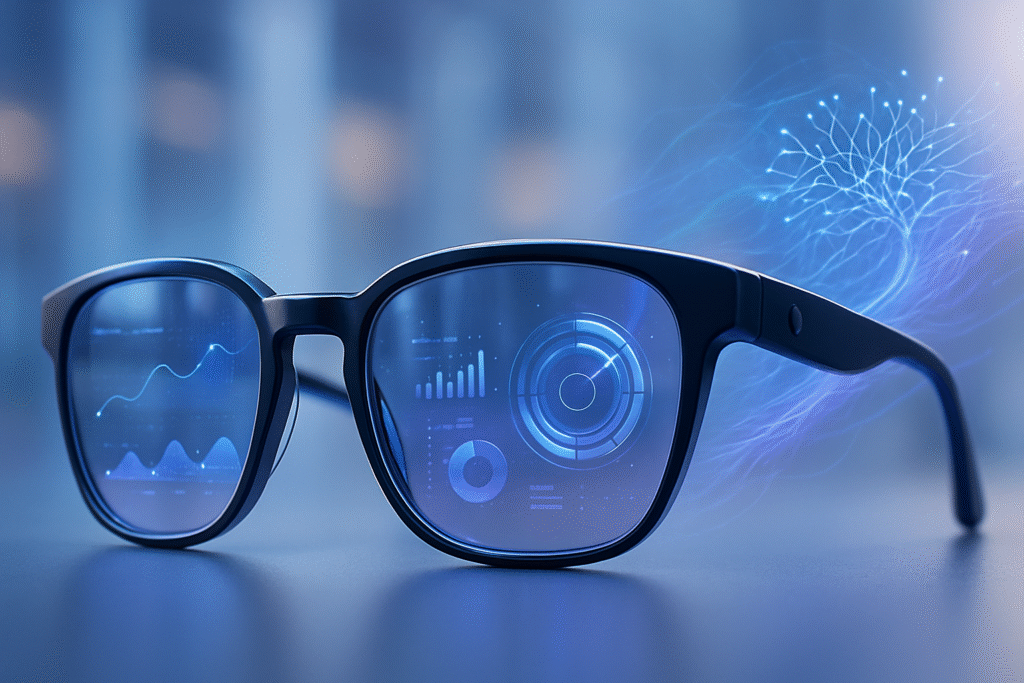
Apple's recent strategic pivot towards accelerating its smart glasses development marks a significant moment in the wearable technology landscape. This aggressive move, which includes reallocating resources from its mixed-reality headset projects, signals the company's intent to dominate the nascent but rapidly growing smart eyewear market. With a keen eye on mainstream adoption and seamless integration into daily life, Apple is positioning its upcoming smart glasses as a critical extension of its ecosystem, heavily relying on advanced Artificial Intelligence to jumpstart their functionality. This acceleration also sets the stage for an intensified competitive battle with Meta Platforms (NASDAQ: META), a company that has already established an early lead in the consumer smart glasses space with its AI-powered Ray-Ban models. The race to define the future of "ambient computing" – where technology intuitively provides information in the background – is officially on, with AI at its core.
Technical Ambitions and AI's Central Role
Apple's accelerated smart glasses initiative involves the development of at least two distinct models, showcasing a nuanced approach to market entry. The first, codenamed N50, is reportedly a display-less version designed to function primarily as an iPhone accessory. Slated for a potential unveiling as early as 2026 and release in 2027, this initial iteration will leverage a connected iPhone for display functions while integrating cameras, microphones, and advanced AI capabilities to emphasize voice interaction. This model aims to reduce iPhone reliance for certain tasks and will offer multiple material and frame options, hinting at a strong fashion accessory positioning. The second, more ambitious model, will feature an integrated display, initially targeted for a 2028 release but now reportedly fast-tracked to directly challenge Meta's recent display-equipped offerings. Both models are expected to house an Apple-designed chip and incorporate health tracking capabilities, underscoring Apple's signature blend of hardware and software integration.
A cornerstone of Apple's smart glasses strategy is a complete overhaul of its voice assistant, Siri. A next-generation Siri, built on new architecture and anticipated in spring 2026, is poised to deliver robust, voice-based commands and power the "Apple Intelligence" features central to the glasses' functionality. This enhanced AI will enable a suite of capabilities, including sophisticated Computer Vision (CV) for real-time object recognition, gesture interpretation, and environmental understanding. Natural Language Processing (NLP) will facilitate seamless hands-free interaction, allowing users to issue commands and receive contextual information, such as directions, real-time language translations, and answers to questions about their surroundings. This differs significantly from previous approaches by focusing on a more integrated, ambient computing experience rather than a mere extension of smartphone features. Initial reactions from the AI research community highlight the potential for Apple's deep integration of on-device AI to set new benchmarks for privacy, performance, and user experience in wearable technology.
The technical specifications emphasize a shift towards embedded, on-device AI, crucial for real-time assistance without constant cloud reliance. This architectural choice is vital for responsiveness, privacy, and reducing latency, which are paramount for an intuitive smart glasses experience. While Meta's Ray-Ban models have showcased multimodal AI assistance and display capabilities, Apple's reputation for meticulous hardware engineering and seamless software integration suggests a potentially more polished and deeply integrated user experience, leveraging its vast ecosystem of devices and services.
Competitive Landscape and Market Implications
Apple's (NASDAQ: AAPL) aggressive push into smart glasses carries significant competitive implications, primarily setting the stage for an intense rivalry with Meta Platforms (NASDAQ: META). Meta has been an early and prolific player in the consumer smart glasses market, launching Ray-Ban Stories in 2021 and the more advanced Ray-Ban Meta in 2023. Most recently, in September 2025, Meta unveiled its "Meta Ray-Ban Display" glasses, which feature a full-color, high-resolution display in one of the lenses and robust multimodal AI assistance, retailing from $799. Meta is widely considered to have a more advanced AI product in the smart glasses space at present, having iterated rapidly and focused on an "AI-first" approach with a robust developer toolkit for "ambient computing."
Apple's entry, therefore, directly challenges Meta's early lead and market positioning. While Meta has prioritized iteration and scale, Apple is known for its meticulous hardware polish, seamless ecosystem integration, and deep software features. This "race for your face" is expected to significantly expand the wearable AI market, benefiting consumers through accelerated innovation. Companies like Qualcomm (NASDAQ: QCOM), which provides chips for many AR/VR devices, and other component manufacturers could also stand to benefit from the increased demand for specialized hardware. Potential disruption to existing products or services could include a gradual shift away from smartphone reliance for quick information access, although a complete replacement remains a long-term vision. Apple's strategic advantage lies in its massive user base, established ecosystem, and brand loyalty, which could facilitate rapid adoption once its smart glasses hit the market.
The differing approaches between the two tech giants highlight distinct strategies. Meta's open-ended platform and focus on social interaction through AI are contrasted by Apple's typical walled-garden approach, emphasizing privacy, premium design, and deep integration with its existing services. This competition is not just about hardware sales but about defining the next major computing platform, potentially moving beyond the smartphone era.
Broader Significance and Societal Impacts
Apple's accelerated smart glasses development fits squarely into the broader AI landscape and the burgeoning trend of "ambient computing." This shift signifies a move away from the isolated, screen-centric interactions of smartphones and traditional computers towards a more pervasive, context-aware, and seamlessly integrated technological experience. The immediate significance is a clear signal from one of the world's most influential tech companies that lightweight, AI-powered augmented reality (AR) wearables, rather than bulky virtual or mixed reality headsets like the Vision Pro, hold the true potential for mainstream adoption. This pivot marks a strategic re-evaluation, acknowledging the challenges of mass-market appeal for high-priced, specialized VR/MR devices and prioritizing practical, everyday AR.
The impacts of this development are manifold. For users, it promises a more natural and less intrusive way to interact with digital information, potentially reducing screen fatigue and enhancing real-world experiences. Imagine receiving subtle directions overlaid on your vision, real-time translations during a conversation, or instant information about objects you're looking at, all without pulling out a phone. However, this also raises potential concerns regarding privacy, data collection, and the ethical implications of omnipresent AI. The continuous capture of environmental data, even if processed on-device, necessitates robust privacy safeguards and transparent user controls. There are also societal implications around digital distraction and the blurring lines between physical and digital realities, which will require careful consideration and regulation.
Comparisons to previous AI milestones and breakthroughs are apt. Just as the iPhone democratized mobile computing and the Apple Watch popularized smart wearables, Apple's smart glasses could usher in a new era of personal computing. The integration of advanced AI, particularly the next-generation Siri and on-device processing for computer vision and natural language, represents a significant leap from earlier, more rudimentary smart glasses attempts. This move aligns with the industry-wide trend of bringing AI closer to the user at the edge, making it more responsive and personalized, and solidifying the vision of AI as an invisible, always-on assistant.
Future Developments and Expert Predictions
The immediate future will see Apple's strategic rollout of its smart glasses, with the display-less N50 model potentially arriving as early as 2027, following an anticipated unveiling in 2026. This initial offering is expected to serve as an accessible entry point, familiarizing users with the concept of AI-powered eyewear as an iPhone extension. The more advanced, display-equipped model, now fast-tracked, is projected to follow, aiming for a direct confrontation with Meta's increasingly sophisticated offerings. Experts predict that Apple will initially focus on core functionalities like notifications, contextual information, and enhanced communication, leveraging its revamped Siri and "Apple Intelligence" features.
Long-term developments envision smart glasses evolving into a primary computing device, potentially reducing or even replacing the need for smartphones. Applications and use cases on the horizon include highly personalized health monitoring through integrated sensors, advanced augmented reality gaming and entertainment, seamless professional collaboration with real-time data overlays, and transformative accessibility features for individuals with sensory impairments. Imagine real-time speech-to-text translation appearing in your field of view for the hearing impaired, or visual descriptions of surroundings for the visually impaired.
However, significant challenges need to be addressed. Miniaturization of powerful components, battery life, social acceptability, and the development of compelling, intuitive user interfaces are critical hurdles. Ensuring robust privacy and security measures for highly personal data captured by these devices will also be paramount. Experts predict that the next few years will be a period of intense innovation and competition, with both Apple and Meta pushing the boundaries of what's possible. The success of smart glasses will ultimately hinge on their ability to offer truly indispensable value that seamlessly integrates into daily life, rather than merely adding another gadget to our already saturated digital existence.
A New Era of Ambient Computing Dawns
Apple's accelerating commitment to smart glasses development marks a pivotal moment in the evolution of personal technology, underscoring a strategic shift towards a future where computing is more ambient, intuitive, and seamlessly integrated into our daily lives. The key takeaways from this development are Apple's clear prioritization of lightweight, AI-powered AR wearables over bulkier VR/MR headsets for mainstream adoption, its direct challenge to Meta Platforms' early lead in the consumer smart glasses market, and the central role of advanced AI, particularly a next-generation Siri, in jumpstarting this technology.
This development's significance in AI history cannot be overstated. It represents a major step towards realizing the long-held vision of augmented reality as the next major computing platform. By bringing sophisticated AI, including computer vision and natural language processing, directly to our faces, Apple is poised to redefine how we interact with information and the world around us. This move is not just about a new product category; it's about a fundamental reorientation of human-computer interaction, moving beyond screens to a more natural, context-aware experience.
The long-term impact of this "race for your face" between Apple and Meta will likely accelerate innovation across the entire tech industry, fostering advancements in AI, miniaturization, battery technology, and user interface design. Consumers can anticipate increasingly sophisticated and useful wearable AI devices in the coming years. What to watch for in the coming weeks and months includes further leaks or official announcements regarding Apple's smart glasses specifications, the continued evolution of Meta's Ray-Ban line, and the broader industry's response as other tech giants consider their entry into this rapidly emerging market. The dawn of ambient computing, powered by AI, is here, and the competition to define its future promises to be one of the most exciting narratives in technology.
This content is intended for informational purposes only and represents analysis of current AI developments.
TokenRing AI delivers enterprise-grade solutions for multi-agent AI workflow orchestration, AI-powered development tools, and seamless remote collaboration platforms.
For more information, visit https://www.tokenring.ai/.





